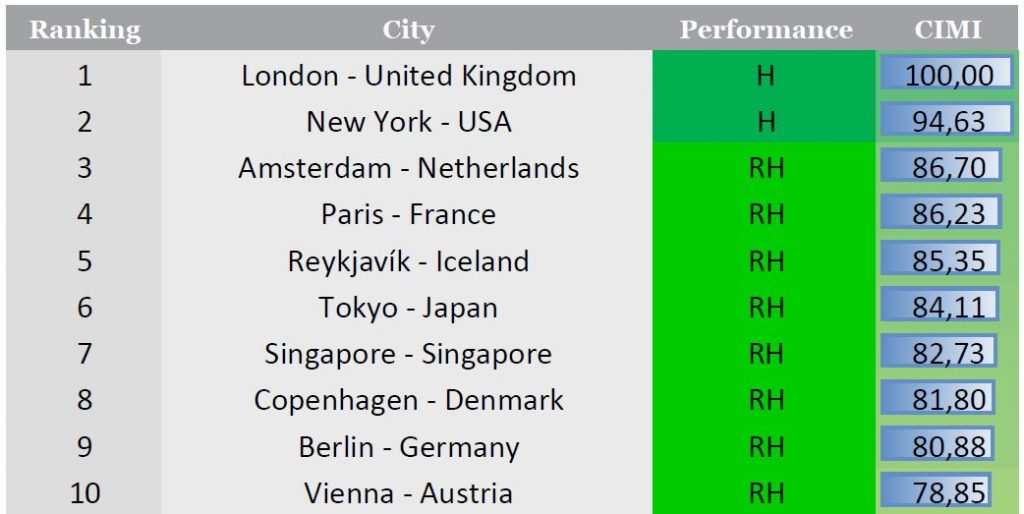For the sixth consecutive year, we are pleased to present the new edition of our IESE Cities in Motion Index (CIMI). Over the past years, we have observed how various cities, companies and other social actors have used our study as a benchmark when it comes to understanding the reality of cities through comparative analysis.
In today’s increasingly urban world, it is becoming more and more critical to expand the knowledge and tools available to better understand the different factors that allow cities to improve their competitiveness, ensure their sustainability and enhance the quality of life of their inhabitants. The IESE Cities in Motion Index aims to contribute to this better understanding of the reality of cities by providing an objective, wide-ranging and holistic index that covers different key dimensions of metropolises. The nine main dimensions of our model are human capital, social cohesion, the economy, public management, governance, the environment, mobility and transportation, urban planning, international outreach, and technology.

CIMI 2019: Updates
As in every edition, we have tried to improve the structure and coverage of the CIMI and this edition has been no exception. First, the 2019 edition has significantly increased the number of variables in relation to the cities, including a total of 96 indicators – 13 more than in the previous edition -. Among the new variables, there are, for example, the hourly wage, purchasing power, mortgage as a percentage of income, and whether a city is a favorable environment for the development of women. This increase in the quantity and quality of the variables used allows for a more accurate assessment of the reality of the cities that appear in the CIMI.
Additionally, the 2019 edition has also widened its geographical coverage by adding 11 new cities, including Quebec (Canada), Edinburgh (United Kingdom) and Seattle (United States), among others. The CIMI 2019 includes 174 cities – 79 of them capitals – representing 80 countries, for three consecutive years (2016-2018).
General Ranking
Year after year, the top position in the ranking seems to be disputed by London and New York, two highly developed and smart cities. After three consecutive years with New York at the top place, London has taken back the first position, followed by New York (#2) and Amsterdam (#3). The rest of the top 10 cities in the overall ranking are Paris (#4), Reykjavik (#5), Tokyo (#6), Singapore (#7), Copenhagen (#8), Berlin (#9) and Vienna (#10).

London
 London is in first position in the overall ranking thanks to its very good performance in almost all of the dimensions. The British capital ranks in 1st position in human capital and international outreach, 3rd in mobility and transportation, 7th for the governance dimension, 8th in technology and 9th in urban planning. However, the city does not show such a good performance in the dimensions of social cohesion (#45) and the environment (#34).
London is in first position in the overall ranking thanks to its very good performance in almost all of the dimensions. The British capital ranks in 1st position in human capital and international outreach, 3rd in mobility and transportation, 7th for the governance dimension, 8th in technology and 9th in urban planning. However, the city does not show such a good performance in the dimensions of social cohesion (#45) and the environment (#34).
New York
 This year, the Big Apple is in second place in the overall ranking, but it enjoys the leading position in the economy dimension. New York also stands out in other dimensions, such as human capital (#3), urban planning (#2), mobility and transportation (#5), international outreach (#8) and technology (#11). However, the city performs worse in the social cohesion dimension (#137).
This year, the Big Apple is in second place in the overall ranking, but it enjoys the leading position in the economy dimension. New York also stands out in other dimensions, such as human capital (#3), urban planning (#2), mobility and transportation (#5), international outreach (#8) and technology (#11). However, the city performs worse in the social cohesion dimension (#137).
Amsterdam
 The capital of the Netherlands completes the podium of the CIMI 2019 ranking. Being a leading center for finance and trade, the city is also an important cultural and touristic hub. Amsterdam performs well overall in the ranking and stands out especially in international outreach (#3), technology (#7), the economy (#10), urban planning (#11), and mobility and transportation (#11).
The capital of the Netherlands completes the podium of the CIMI 2019 ranking. Being a leading center for finance and trade, the city is also an important cultural and touristic hub. Amsterdam performs well overall in the ranking and stands out especially in international outreach (#3), technology (#7), the economy (#10), urban planning (#11), and mobility and transportation (#11).
Regional Ranking
Europe clearly dominates the top spots in the ranking, with seven Western European cities in the top ten positions. Moreover, if we expand the focus to the top 50 positions, the dominance of Europe is still evident, with more than half of the cities being on this continent. Figure 2 below exhibits how the different regions are represented in the overall ranking in accordance to their performance. It can be observed that the group with the best performing cities, the one with darker green, is mainly made up by Western European cities (with more than half of them), followed by North America (11%) and the Asia Pacific region (11%).

Creating Smarter and More Sustainable Cities
The Cities in Motion Index offers a broad and holistic vision of what a city represents, taking into account different key dimensions to create smarter and more sustainable cities. Our index aims to be a helpful tool that will allow cities and their leaders to carry out a first diagnosis to identify strengths and point out aspects where there may be room for improvement. However, the CIMI should serve as a source of inspiration and an initial benchmark, rather than a road map for action.
Finding the right balance among the different dimensions is a complex – and permanent – process. Urban leaders need to take an all-embracing and long-term vision to establish strategic priorities to carry out the necessary transformations. However, it is important to take into account that the perfect city does not exist and that change is slow for most cities. Collaboration among the different stakeholders and participation of the public have proven to be driving forces for change and success.
The urbanization process presents one of the most significant challenges of the 21st century, with increasing effects on the economy, social divisions and environmental impacts. However, it also creates new opportunities to design, build and operate smarter, greener and more inclusive cities. A better understanding of the realities of cities is the key to succeed in this process of transformation. With the IESE CIMI 2019 report, we hope to have contributed to advancing this process.
You can download the full report here: IESE Cities in Motion Index 2019.
More information on the offical website of IESE Cities in Motion Index and IESE Insight.


Awesome report and great job.
“A better understanding of the realities of cities is the key to succeed in this process of transformation.”
Totally agree and that is why is important you research work.
With your permision, we share with our team.
Qué interesante. Gracias por la información
Greetings,
Firstly thank you for this ranking
I’m a Cameroonian doing some research on the topic and I have a couple of questions.
On what basis are the cities chosen
Is it possible to consult the methodology used? as well as the data?
Hi Morrelle, thank you for your comment.
You can find more information about how the Index is developed by checking the report here. Hope you find this information useful!
Best regards,
Renata
Awesome report and great job.
“A better understanding of the realities of cities is the key to succeed in this process of transformation.”
Totally agree and that is why is important you research work.
With your permision, we share with our team.